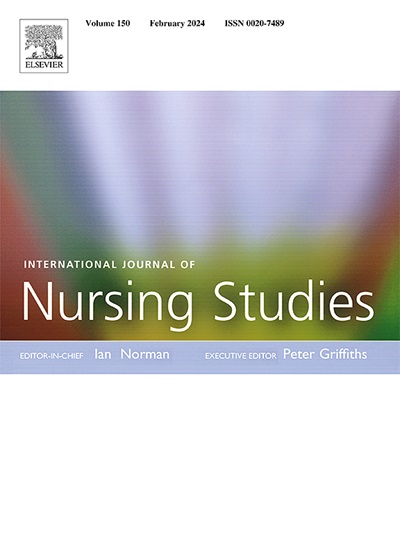探索疗养院中未完成护理与个人、团队气氛和组织因素的关系:一项观察性研究。
IF 7.1
1区 医学
Q1 NURSING
引用次数: 0
摘要
背景:全球养老院的护理人员报告未能全面提供基本护理。这种未完成护理的现象对居民产生了不利的影响。人员配备水平不足与未完成的护理有关,但仅凭这一点并不能解释其普遍性。未完成护理出现在一个复杂的现实中,需要了解其与护理工作者个人因素、团队氛围和组织因素的关系。这些关联主要是在急性护理环境中研究的。目的:探讨个人、团队氛围和组织因素与养老院未完成护理的关系。设计:一项利用两个横断面数据来源的观察性研究。机构:芬兰共有18所公立养老院,共122个单位。参与者:护工(n = 503)在这些养老院单位提供护理。方法:数据来自同一疗养院单位的两个不同的数据集。第一个数据集包括来自芬兰国家公共部门(FPS)研究的养老院单位水平的结果。第二个数据集包括护理人员对未完成护理的问卷调查。多元线性回归分析检验了相关性。结果:在日常生活活动(β = 0.186, 95% CI 0.071-0.302)、护理、康复和监测(β = 0.260, 95% CI 0.155-0.366)、文献记录(β = 0.376, 95% CI 0.221-0.530)和社会护理(β = 0.487, 95% CI 0.301-0.673)四种护理类型中,非护理任务与未完成护理的增加有统计学意义。更好的工作幸福感(β = -0.123, 95% CI -0.233至-0.012)与社会护理中未完成护理的减少相关。临时雇佣合同与护理、康复和监测方面未完成护理的减少(β = -0.193, 95% CI -0.366 ~ -0.020)和社会护理(β = -0.357, 95% CI -0.720 ~ -0.042)相关。未完成护理与团队氛围因素之间无临床显著相关性。结论:已确定的与养老院未完成护理的关联突出了这一复杂问题,但确切的机制仍不清楚,需要进一步调查。未来的研究应集中在护理领导和决策过程,以更好地理解潜在的机制,可能解释未完成的护理。本文章由计算机程序翻译,如有差异,请以英文原文为准。
Exploring the associations of unfinished nursing care with individual, team climate, and organizational factors in nursing homes: An observational study
Background
Care workers in nursing homes globally report failing to comprehensively provide essential nursing care. This phenomenon of unfinished nursing care has adverse impacts on residents. Inadequate staffing levels are associated with unfinished nursing care, but this alone does not explain its prevalence. Unfinished nursing care emerges in a complex reality, requiring knowledge of its associations with care workers' individual factors, team climate, and organizational factors. These associations have mainly been studied in acute care settings.
Objective
To explore associations between individual, team climate, and organizational factors and unfinished nursing care in nursing homes.
Design
An observational study utilizing two cross-sectional data sources.
Setting(s)
Eighteen publicly owned nursing homes with 122 units in Finland.
Participants
Care workers (n = 503) delivering nursing care in these nursing home units.
Methods
Data were obtained from two different datasets drawn from the same nursing home units. The first dataset consisted of results at the nursing home unit level from the national Finnish Public Sector (FPS) study. The second dataset consisted of questionnaire responses from care workers related to unfinished nursing care. Multiple linear regression analysis examined the associations.
Results
Non-nursing tasks were statistically significantly associated with increased unfinished nursing care in all four care types: activities of daily living (β = 0.186, 95 % CI 0.071–0.302), caring, rehabilitation and monitoring (β = 0.260, 95 % CI 0.155–0.366), documentation (β = 0.376, 95 % CI 0.221–0.530) and social care (β = 0.487, 95 % CI 0.301–0.673). Better work-related well-being (β = − 0.123, 95 % CI − 0.233 to − 0.012) was associated with decreased unfinished nursing care in social care. Temporary employment contracts were associated with decreased unfinished nursing care in caring, rehabilitation and monitoring (β = − 0.193, 95 % CI − 0.366 to − 0.020) and social care (β = − 0.357, 95 % CI − 0.720 to − 0.042). No clinically significant associations were found between unfinished nursing care and team climate factors.
Conclusions
The identified associations with unfinished nursing care in nursing homes highlight this complex issue, but the exact mechanisms remain unknown and require further investigation. Future studies should focus on nursing leadership and decision-making processes to better understand the underlying mechanisms potentially explaining unfinished nursing care.
求助全文
通过发布文献求助,成功后即可免费获取论文全文。
去求助
来源期刊
CiteScore
15.00
自引率
2.50%
发文量
181
审稿时长
21 days
期刊介绍:
The International Journal of Nursing Studies (IJNS) is a highly respected journal that has been publishing original peer-reviewed articles since 1963. It provides a forum for original research and scholarship about health care delivery, organisation, management, workforce, policy, and research methods relevant to nursing, midwifery, and other health related professions. The journal aims to support evidence informed policy and practice by publishing research, systematic and other scholarly reviews, critical discussion, and commentary of the highest standard. The IJNS is indexed in major databases including PubMed, Medline, Thomson Reuters - Science Citation Index, Scopus, Thomson Reuters - Social Science Citation Index, CINAHL, and the BNI (British Nursing Index).

 求助内容:
求助内容: 应助结果提醒方式:
应助结果提醒方式:


